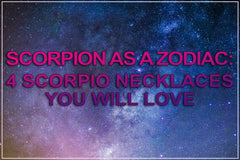
Necklaces are one of the most popular jewelry categories in the world.
The history of jewelry and necklaces goes way back. In fact, according to the International Gem Society, the earliest jewelry finding is a necklace. It's a simple necklace made of fishbones dating back ~25,000 years found in a cave in Monaco.
Although we are all familiar with the word necklace and its general meaning as a piece of jewelry worn around the neck, do we really understand what it contains?
From the different types of necklaces to materials, common questions, and choosing the best one to wear with your current outfit, this article will go through everything you need to know about necklaces.
In this guide, you'll learn:
Necklace types
Chains
Bead

On the left: white beaded flower choker • On the right: colorful beaded flower necklace
A bead chain necklace is exactly what it sounds like; a chain made of beads.
Although typically, the beads are made of natural stone, metal, or precious metal, the beads can come in different sizes, colors, or shapes.
Box

On the left: 2mm rose gold box chain • On the right: 4mm box chain necklace
A box chain necklace, also known as the Venetian chain, is a well-known metallic chain style with a smooth, four-sided design with every link resembling a box.
Each link on the box chain is a square- or round-shaped piece that connects to the following link forming a box-like aesthetic to the chain.
Byzantine

On the left: chunky gold byzantine chain • On the right: 6mm byzantine chain in 14k yellow gold
A byzantine chain is an intricate chain design that mixes the box and rope chain into a slightly messy-looking yet organized appearance.
Most byzantine chains are made from metals and precious metals, like gold and silver, and the chain can be round or square-shaped by design.
Cable

On the left: 1.2mm gold cable chain • On the right: 3mm cable chain necklace
A cable chain consists of uniform oval links that interlock together, forming a simple, durable, and lightweight chain design.
For many, the cable chain necklace is the first thing that comes to mind when asked to think about a chain. In addition, the versatility of the cable chain makes it the best chain to get if you are new to necklaces or jewelry in general.
Curb

On the left: 3mm gold curb chain choker • On the right: 7mm curb chain necklace
A curb chain, also called a Cuban chain, is a flat chain design with round or oval links, often with a faceted surface.
It's a durable link arrangement often worn in larger sizes and without a pendant. Like most chain necklaces, the curb chain material composition usually consists of metals like gold, silver, or stainless steel.
Figaro
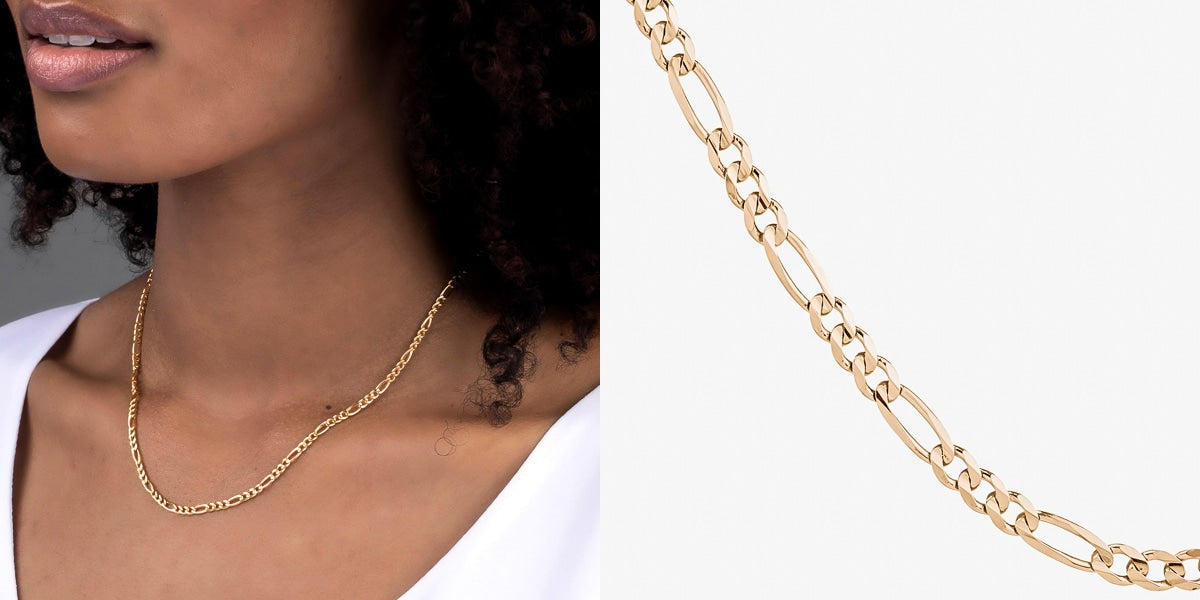
On the image: gold figaro chain necklace
The figaro chain is one of the most recognizable necklace designs in the world. Its iconic link pattern of three round links followed by a single elongated oval link, along with the flat aesthetic, makes the figaro one of the most beautiful chains in the world.
Although many prefer to wear the figaro chain without a pendant, the elegant design looks equally as good when worn with a pendant.
Franco

On the image: gold franco chain necklace
The franco chain is a more complex, three-dimensional variation of the curb chain. It features two mirrored curb chain links side-by-side as a single link. When put together, the links form what is known as a franco chain.
Although the franco chain is unisex, it is more often seen worn by men. In addition, most franco chains are worn as they are, without any added charms or pendants.
Herringbone

On the left: 4mm gold herringbone chain • On the right: 3mm gold herringbone chain
A herringbone chain is a flat snake-like chain necklace. The chain consists of tiny flat links that are slightly bent from the middle, giving the chain its iconic herringbone pattern.
Although it resembles a snake pattern at first glance, the herringbone is not the same as a snake chain. To learn more about how the herringbone differs from a regular snake chain, keep reading.
Paperclip

On the left: gold paperclip chain necklace • On the right: silver paperclip chain
A paperclip chain, sometimes also called an oval-link chain, is a lightweight chain with simple long, elongated links. Although the links are often oval, square-shaped links aren't uncommon on paperclip chains.
The paperclip chain is actually a version of the classic cable chain. The only difference is that the links on a paperclip chain are significantly elongated, while the cable chain utilizes round or only slightly oval links.
Pearl

On the image: 6-7mm freshwater pearl choker chain necklace
A pearl chain is one of the most loved necklace styles of our time. It's a necklace that forms from consecutive pearl beads, usually connected by a strong string or silver chain.
All pearl chains consist of round, oval, drop, button, circled, or baroque-shaped pearls. In addition, although most pearl chains utilize natural pearls like freshwater or south sea pearls, there are semi-natural options like shell pearls and imitation alternatives like plastic pearls on the market, as well.
Rolo

On the image: 5mm rolo chain necklace
A rolo chain, also known as rollo chain, is a slightly thicker and rounder version of the cable chain. In fact, the two chain types are often used and talked about interchangeably.
The difference between a rolo chain and a cable chain is link width and weight. While the links on a cable chain are thinner and seem like they are made from metal wire, the rolo chain employs thicker metal that resembles metal strips rather than wire.
Rope

On the image: 6mm gold rope chain necklace
A rope chain is one of the most wanted necklace styles in the world. It consists of a string of links that form a round and twisted, rope-like appearance.
Although there are a few close variations of the style, all rope chains share the same appearance of two smaller strings twisting around each other to form the complete rope aesthetic.
San Marco

On the image: gold san marco chain necklace
A San Marco chain is a necklace-type with diagonally connected links that are smooth and round on the front side. The links are cut or sawed from the middle, resulting in a flat surface on the backside.
Because the links on a San Marco chain are round all the way through, it is not a version of the rope chain but its own chain type.
Satellite

On the image: silver satellite baroque pearl necklace
A satellite chain is a necklace style with beads sprinkled evenly throughout a solid chain. Although the beads are usually identical in size, they can also alternate in shape or size.
Most satellite chains consist of a metal chain and beads. Others, like the one seen in the image above, utilize a combination of two materials like sterling silver and natural stone, like pearls.
Serpentine

On the image: gold serpentine chain necklace
A serpentine chain is made from flattened S-shaped links that interlock firmly. The connected links on a serpentine chain resemble the number eight or the infinity symbol.
The wavy design of the serpentine chain necklace is quite strong. However, if it breaks, the repair can be a hassle.
Singapore

On the image: gold singapore chain necklace
The Singapore chain consists of a series of thin, round curb chain links that twist around each other, creating a twisted appearance to the necklace.
Essentially, the Singapore chain is a blend of curb and rope chains. Although some wear a Singapore chain without an added pendant or charm, the chain is often combined with a pendant.
Snake

On the left: thin silver snake chain • On the right: 2mm gold snake chain necklace
The snake chain is a necklace style constructed from tiny links that limit the chain's movement to resemble a moving snake.
The difference between a snake chain and a herringbone chain is that, unlike the flat aesthetic of the herringbone chain, the snake chain is completely round throughout.
Tennis

On the image: 3mm silver tennis chain necklace
A tennis chain necklace consists of a metal or precious metal chain with a gemstone attached to each link with a prong setting. High-end tennis chains usually display diamonds, while crystal and cubic zirconia are used on more affordable tennis chains.
The classic tennis chain consists of sterling silver or a platinum base and clear white diamonds or crystals attached to every link. Occasionally, colored gemstones are seen on tennis necklaces like this one with pink crystals.
Wheat
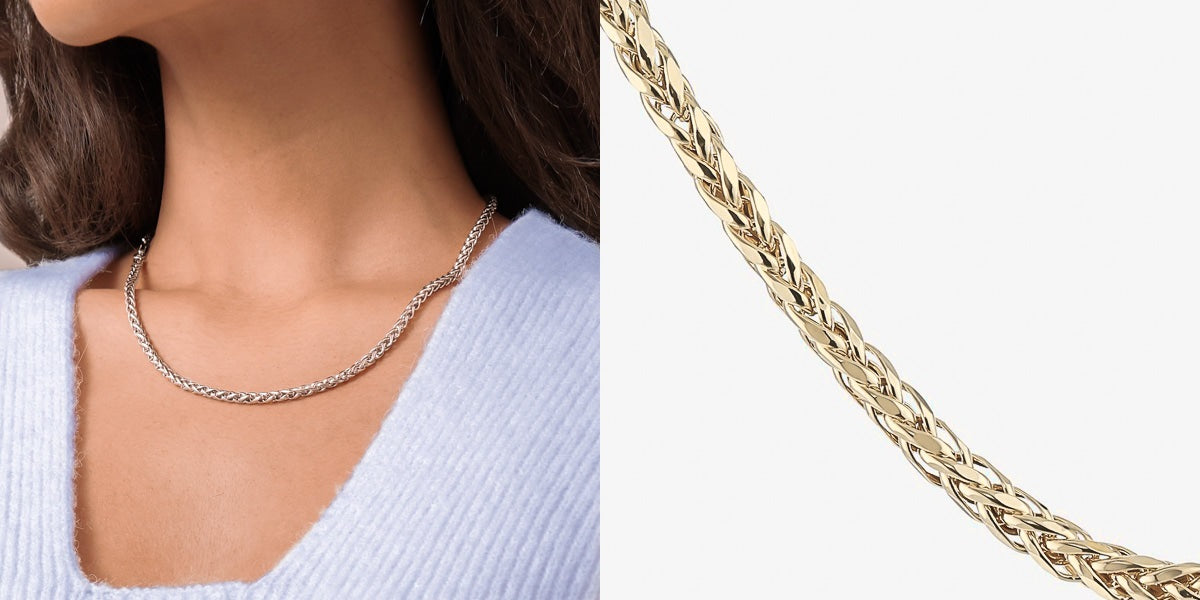
On the left: 4mm silver wheat chain • On the right: gold wheat chain necklace
The wheat chain, sometimes also called Spiga chain or braid chain, gets its name from how each link closely resembles the shape of a wheat spike.
It's one of the classic chain types that looks amazing by itself and with a pendant. In addition to its versatility, the wheat chain is one of the most durable chains in the world, thanks to its complex link structure.
Necklaces
Bib

A bib necklace is a sizeable formal necklace style that covers broad parts of the décolletage and upper chest, leaving the upper side of the collarbones exposed.
Bib necklaces are often seen in colorful designs that employ a mixture of different precious metals, stones, and gems. Many celebrities, public figures, and royalty have attended celebratory events with a bib necklace.
Charm

On the left: gold conch shell charm necklace • On the right: gold layered star charm necklace
A charm necklace consists of a charm or multiple small ornaments and a chain that carries the charms. Anything the necklace wearer considers to bring them luck or affect them in any positive manner can be regarded as a charm.
While some don't believe in luck or fate, others can find the superstition behind charms and charm necklaces to bring confidence and even happiness into their daily lives.
Choker

On the left: gold open heart choker necklace • On the right: 6mm pearl choker necklace
A choker necklace is actually a name for a specific length necklace. However, because the popularity of chokers exploded during the past ten years, it can be comfortably included as its own necklace category today.
Chokers sit just above the collarbones and usually fit semi-tightly against the base of the throat, just above the collarbones.
Drop / Lariat

On the left: gold drop bar lariat necklace • On the right: silver lariat drop chain necklace
The drop necklace, also known as the lariat necklace, is a long, low-hanging style that sits on or below the bust. It's an elegant style, often seen in combination with long v-necks and spaghetti straps.
A drop necklace is sometimes called the Y necklace because the connecting chains and the drop together form a Y-shape on the chest.
Festoon

A festoon is a festive necklace style that usually contains an arrangement or a collection of gems or other precious or semi-precious stones and crystals. It is typical for a festoon necklace to portray itself in multiple layers or sections displayed on the wearer's upper chest area.
The word festoon derives from the Latin word festo, meaning feast, festive, or holidays. According to Lang Antique Jewelry, festoons became popular during the neoclassical period (late 1700s).
Lavalier

On the left: crystal heart & teddy lavalier necklace • On the right: key & lock lavalier necklace
A lavalier describes a necklace-type that has one or more pendulum pendants. Some lavaliers display a regular pendant with a pendulum pendant attached to it.
Some mistakenly call the lavalier a Y necklace. While Y necklaces are close to lavalier in terms of aesthetics, Y necklaces are actually a lariat or a drop chain necklace rather than a lavalier.
Layered

On the left: layered three-tone snake chain necklace • On the right: gold layered pearl necklace set
A layered necklace is a specific necklace style where a single necklace separates into two or more chains, creating a layered appearance.
Some layered necklaces are controlled by a single clasp, while other styles can be worn individually, outside the intended layered set.
Letter / Initial

On the left: simple gold initial letter necklace • On the right: colorful crystal initial necklace
An initial necklace, also known as a letter necklace, describes a necklace that features a single letter, either integrated into the chain or as a pendant.
Because so many want the letter to represent the initial of their name, the necklace style is more commonly known as the initial rather than the letter necklace.
Locket

On the image: gold heart locket pendant necklace
A locket is a necklace with a pendant with a small internal compartment. The most common use case for a locket is to store a picture or a tiny memorial of a close person and safely carry it with you wherever you go.
Although lockets have traditionally served to carry a picture of a loved one who has already passed, they can be used, for example, to bring photos of your siblings or children with you.
Pearl
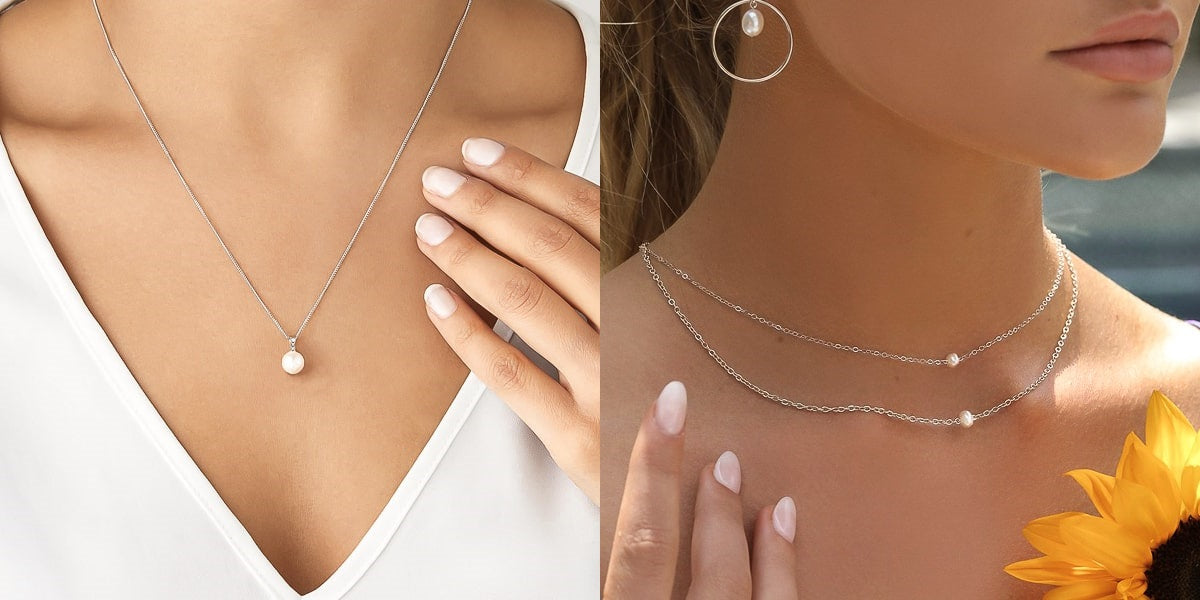
On the left: freshwater pearl pendant necklace • On the right: silver single freshwater pearl necklace
A pearl necklace encompasses all necklace styles that utilize a pearl or several pearls in their design. From pearl chains to precious metal chains with a pearl pendant, they are all pearl necklaces.
Unlike a chain made of pearls, a pearl necklace is usually more subtle and modest. Therefore, a pearl necklace is more suitable to wear as an everyday necklace, whereas a pearl chain might be too over the top for daily wearing.
Pendant

On the left: red crystal open heart pendant necklace • On the right: silver crystal halo pendant necklace
A pendant necklace is the most common type of necklace in existence. It describes a necklace style that features a pendant or a charm hanging from the chain.
The pendants can alter in terms of material, size, color, and texture. However, if the chain has a charm, either removable or integrated, it's a pendant necklace.
Protection

On the left: gold hamsa necklace • On the right: gold evil eye necklace
A protection necklace is an amulet or a charm that is believed to shield its wearer from bad luck, mishaps, and evil. In some cases, they are intended to bring good luck, as well.
The Hamsa and the evil eye pendant are some of the most famous protection amulets. Many celebrities and public figures, including Meghan Markle, Jennifer Aniston, and Gigi Hadid, have been spotted wearing them.
Religious

On the left: gold miraculous medal necklace • On the right: gold white crystal cross necklace
A religious necklace means a spiritually or religiously relevant necklace. The most common religious necklace in the world is the cross necklace.
Aside from the Christian cross, the Miraculous Medal, also known as the Medal of the Immaculate Conception, is presumably the most popular religious symbol seen on necklaces today.
Rivière

On the left: 2mm tennis riviere necklace • On the right: 18ct white gold diamond riviere necklace
Rivière is a necklace style consisting of a chain made from independent gemstones. Most rivière necklaces have gems that ascend in size towards the center, while some display equal-sized stones throughout the necklace.
Rivière necklaces are commonly seen in high-end designs, mainly featuring diamonds. However, there are more affordable rivière necklaces made from crystals or zirconias, as well.
Sautoir

The sautoir is a long necklace style that usually involves beads or tassels and can be wrapped around the wrist to wear like a bracelet.
The term sautoir originates from the French language and, according to the Wall Street Journal, was in peak popularity during the early 1900s.
Statement

On the left: floating freshwater pearl necklace • On the right: multicolor freshwater pearl necklace
A statement necklace is a piece of jewelry that sends a powerful message or makes an impact. For example, a rainbow color necklace might not be a statement necklace in itself, but wearing it to a conservative event makes it a statement necklace.
Contrary to popular belief that a statement necklace is always a large piece of jewelry, a statement necklace can be small or big. Even a small necklace can make a statement, albeit a larger chain might be seen more easily.
Toggle
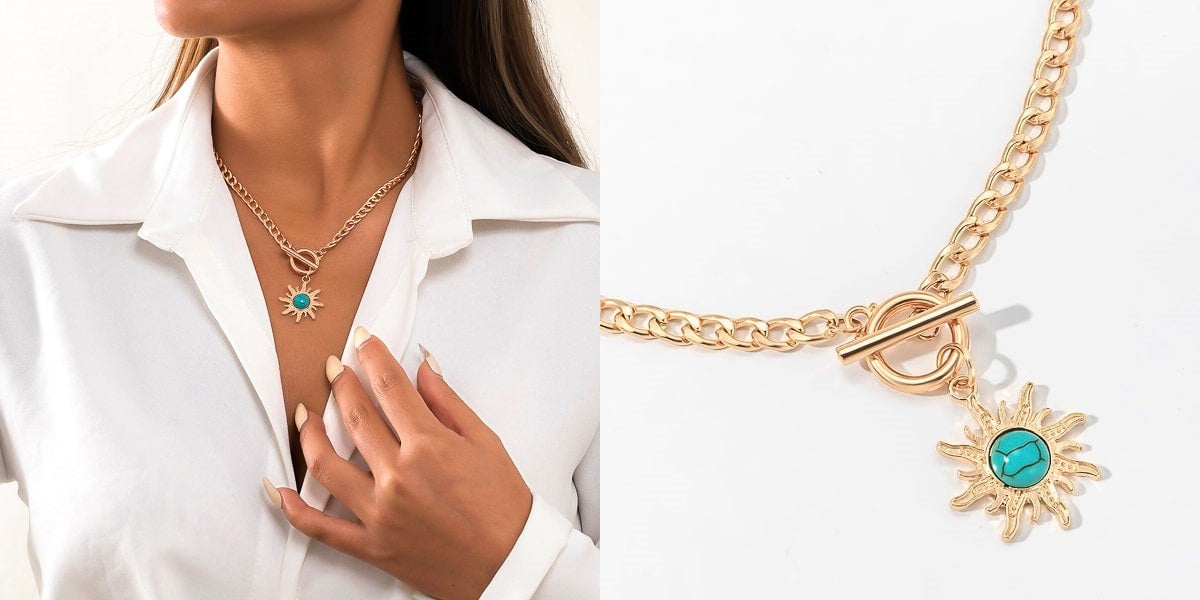
On the image: gold sun toggle necklace
A toggle necklace refers to a necklace closure type. It's a bar clasp that pushes through a round metal ring, locking into a horizontal position against the ring.
Necklaces with a toggle clasp are quick and easy to operate. That's precisely why they have become quite popular in the fashion industry.
Torque

A torque necklace is a rigid or semi-rigid metallic bar, rod, or ribbon, usually with ornamented motifs along the outer side of the chain or at the ends of the bar.
Although most torque necklaces run close to the neck, some reach all the way to the lower chest area. While the torques were originally quite large, they've gotten smaller and more minimalistic in time.
Zodiac

On the left: capricorn constellation necklace • On the right: silver sagittarius zodiac necklace
A zodiac necklace features a specific horoscope's symbol, name, or constellation. In some cases, a zodiac necklace might feature all three together.
Interest in self-development and astrology have exploded the popularity of zodiac necklaces during the past decade. Simple and elegant designs are the most wanter and prominent pieces.
Necklace materials
Metals
Brass

Brass is one of the most common metals used in jewelry and necklaces. It is a yellow metal alloy made from a mixture of copper and zinc.
The main advantages of brass in jewelry are its low price, malleability, and excellent durability.
However, brass is known to oxidize and change color to green in time, so it is mainly used in cheaper necklaces priced at $10 or less.
Zinc Alloy

Zinc is another widely used metal in jewelry making. It is often paired with another metal, like copper or nickel, to create beautiful designs in jewelry.
Some of the more common zinc alloys include brass (zinc & copper) and nickel silver (nickel, copper, & zinc).
Zinc alloys are a popular way to create stunning designs at a low cost. Unfortunately, like brass and nickel silver, most zinc alloys turn green or oxidize quite quickly.
Copper

Copper has been used in necklaces for a long time. It has many benefits, including a reasonably good corrosion resistance that allows it to patinate beautifully in use.
At first, copper necklaces are shiny, metallic orange in color, and in time, they darken. Finally, copper achieves a nice light green color after years of use. Although patinated copper jewelry is rarely seen, an exapmle of the color can be seen on the Statue of Liberty found in New York.
In addition to its corrosion resistance, copper is almost as soft as gold, making it easy to stretch and mold into beautiful, lasting shapes and ornaments.
Plated Metals

Plated jewelry is everywhere nowadays. The most common plated metal you'll see is one with a gold plating. This usually means a copper or brass interior with a small gold layer covering the surface.
Types of plated metals used in necklaces:
- Gold plating: gold plated necklaces often utilize a cheap base metal, such as copper, or an alloy like brass with a thin gold layer covering the surface.
- Silver plating: like gold-plated jewelry, most silver plated pieces have a copper or brass interior with a delicate silver layer on top.
- Platinum plating: platinum includes other metals in the platinum family, like rhodium and iridium. It is often used to brighten or enhance other precious metal jewelry such as sterling silver or white gold necklaces.
- Palladium plating: palladium is used in similar situations as rhodium – to bring out or brighten the surface of precious metal necklaces.
Stainless steel

Stainless steel is the most durable metal used in necklaces. It has a greyish-silver color, but it can be brushed and polished to almost as luminous grey as silver by adding more chromium parts.
Most stainless steel necklaces are made from high-grade SAE 316L stainless steel (also known as A4 or marine grade stainless steel). It's a metal alloy mainly containing iron but also 16-22% chromium, ~10% nickel, ~2% molybdenum, and small quantities of silicon, phosphorus, and sulfur.
In terms of longevity and endurance, stainless steel is the best choice for jewelry. In addition, it has high water and corrosion resistance, allowing people to shower and swim with their stainless steel necklaces.
Silver

Silver is one of the most wanted necklace materials today. Because 100% silver is very soft, most jewelers add a small amount of copper to make the silver jewelry more durable and last longer.
The mixture of silver and copper is most frequently blended in a ratio of 92.5% silver and 7.5% copper. In necklace designs, this exact ratio has become even more popular than pure silver. Today, the mixture goes by the name sterling silver or 925 silver.
Silver is significantly cheaper than gold or platinum yet still shinier than stainless steel or brass, making it a perfect candidate for a high-quality necklace that lasts.
Gold Vermeil

Gold vermeil is sterling silver coated with a thick gold layer (at least 2.5 microns thick). The gold surface is usually either 14 or 18 karat gold but can be as low as 10 karats, as well.
Because gold vermeil necklaces are mainly sterling silver, they are stamped with the same markings as sterling silver (usually a "925" or "sterling" stamp).
Although gold vermeil is a great substitute for more expensive gold necklaces, there's also an option to choose gold-filled jewelry. A gold-filled chain must have at least 5% of its weight in gold, while gold vermeil requirements are set in gold layer thickness.
Gold

Gold is the most famous precious metal used to make necklaces. But, like silver, gold is too soft for everyday jewelry use. That's why almost all gold chains are made from a gold alloy.
Some of the most popular gold alloys are 18 karat gold (75% pure gold) and 14 karat gold (58.5% pure gold). Some high-end jewelers might also sell 22 karat gold jewelry (91.6% gold), but 24 karat gold (99.9% gold) and above is rarely seen on the market. The lowest legal solid gold carat approved for jewelry in the USA is 10 karat gold, which is 41.7% pure gold.
The other metals used to make the gold alloys include copper, zinc, silver, and nickel. The exact ratio can vary depending on where the gold necklace was produced and who made it.
Platinum

Platinum has quickly become one of the favorite materials in jewelry. Although it's a bit pricier than gold, platinum necklaces are often more durable than gold and come with a higher purity – meaning fewer and less added metals.
As a shiny silver-white color metal, platinum is often used as a premium substitute for silver or white gold.
Because of the high price of platinum, there aren't as many manufacturers for platinum necklaces and chains as there are for rings, for example.
Gemstones & crystals
Crystal

Crystals are one of the most wanted stones on necklaces today. They come in every color on the rainbow and can easily be turned into many shapes and designs.
Although they come in various colors, clear white crystal is the most utilized necklace stone out of all crystals. That's because it's used as an inexpensive embellishment to highlight other aspects, as well as a direct substitute for diamonds.
Cubic Zirconia

As for diamond substitutes, there is no better alternative than cubic zirconia. Cubic zirconias are the best and most accurate replacement for a natural diamond in necklaces.
In fact, jewelers identify cubic zirconia from diamonds because diamonds have natural flaws and inclusions, while cubic zirconia is perfect.
Diamond

Diamonds are forever. At least, that's how the saying goes. There is some truth to it, however. A diamond ranks a complete 10/10 on the Mohs hardness scale, making it the hardest substance found on earth.
Some of the more popular diamond necklaces include a tennis chain, solitaire pendant necklace, and heart & cross necklaces featuring diamonds.
Pearl

Pearls have dominated the necklace industry for a long time. Some of the most popular pearl varieties include Akoya, Tahitian, South Sea, and freshwater pearls.
The luster of pearls has intrigued many throughout the years, and because there aren't any prominent competitors for a natural pearl, the popularity isn't going to lose steam anytime soon.
Natural stones

Natural stones include many beautiful alternatives ranging from solid blue stones like Lapis Lazuli to translucent and radiant gems like the opal.
The main advantage of choosing a natural stone necklace is that it's guaranteed to be unique, regardless of the stone variety you choose.
Necklace lengths
Necklaces can be broadly categorized into three length brackets; tight, exact, and loose fit. To learn more about what necklace length best suits your style, see our necklace length guide.
Tight fit
The two tightly fitting necklace lengths are collar and choker style necklaces. While both sit high on the neck, there are some inherent differences between the two.
Collar

On the left: red beaded flower collar choker necklace • On the right: silver single bead collar necklace
A collar sits tightly and high on the neck. The length of a choker necklace is defined as being 12-14" or 31-36cm in length. However, this is just a general guideline.
Depending on the size of your neck, a collar choker that fits you perfectly for you might be slightly shorter or longer than what the general guideline suggests.
Choker

On the left: 4mm pearl choker necklace • On the right: 6mm gold rope chain necklace
A choker is a semi-tight necklace length that sits against the base of the throat. Its length is officially defined as 14-16" or 36-41cm.
Again, as the length is merely a reference, the size of your neck is the final determiner of what necklace length actually fits you as a choker.
Exact fit
Most necklaces on the market are either exact fit or very close to it. The exact fit length bracket only contains one necklace length; the princess fit.
Princess

On the left: gold carre cut crystal necklace • On the right: gold dog tag necklace
A princess-fit necklace falls properly on or just below the collarbone. The length of a princess fit chain is 17-19" or 43-48cm.
Because the length measurement leaves 2" or 5cm for wiggle room, some princess chains rest right at the bottom of the collarbone. Other princess necklaces, especially ones with a pendant, hang on the upper parts of the décolletage.
Loose fit
Loosely fitting necklaces rest on or below the upper chest area. The loose-fit chains can be specified in three categories; matinee, opera, and rope/lariat necklaces.
Matinee
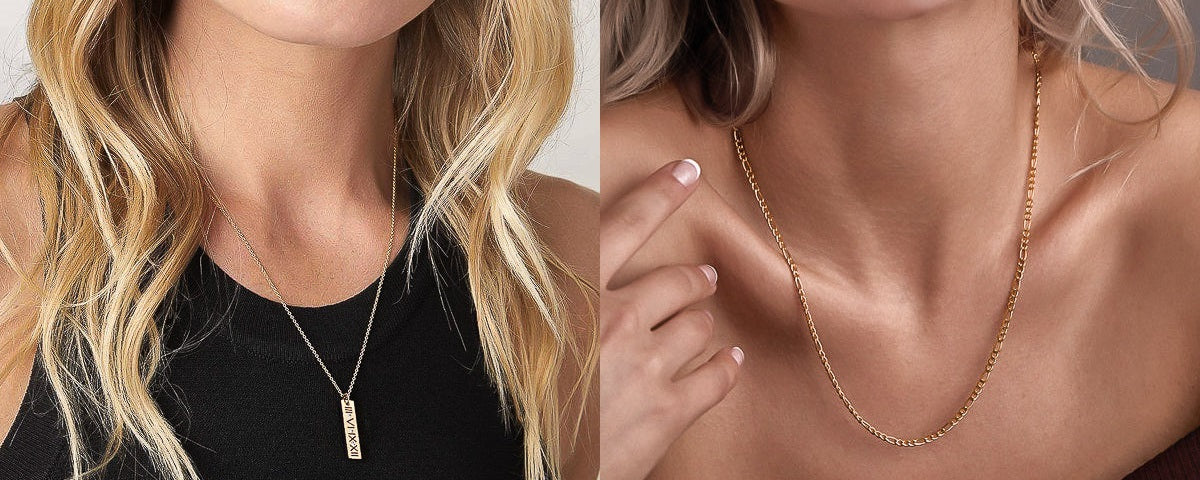
On the left: roman bar of wisdom necklace • On the right: 3mm gold figaro chain necklace
Matinee necklaces fall between the collarbone and the bust, usually right in the middle. The length of a matinee necklace is defined as 20-24" or 51-61cm.
Matinee is the shortest necklace length category that you can put on and take off without unlocking the clasp. If you can't take the necklace off without opening the lock, you'll know it's a longer version of the princess-fit necklace instead of a matinee.
Opera
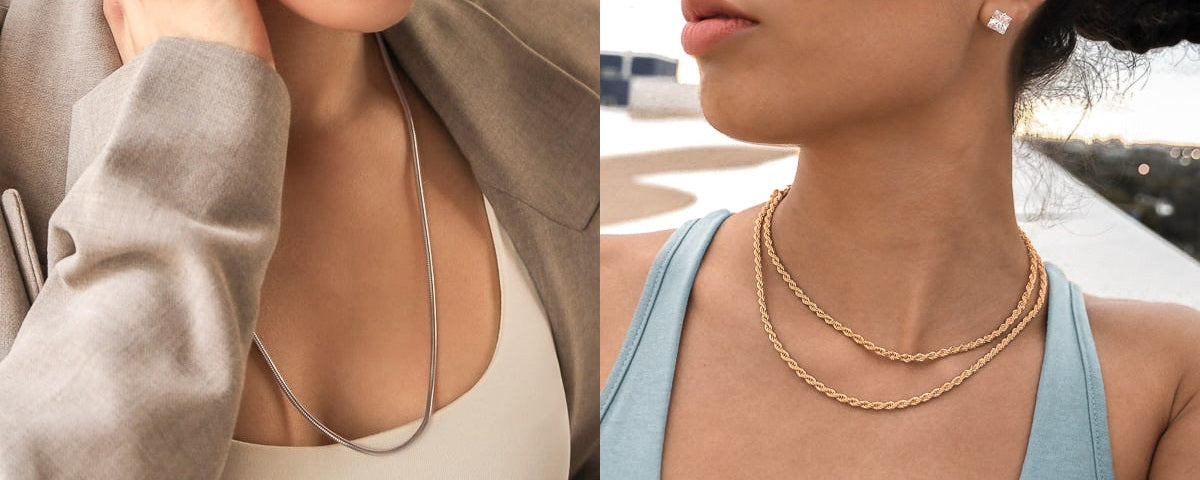
On the left: silver snake chain necklace • On the right: gold rope chain necklace
An opera-fit necklace sits on or just below the bust. The general length range of an opera necklace is between 28-36" or 71-91cm.
The longer opera chains can also be worn similarly to a choker or princess-fit necklace by wrapping them twice around the neck. This gives the impression of two shorter necklaces and adds depth to an outfit.
Rope

Rope length is the lengthiest necklace category available. Rope length necklaces are classified by a length of 38" or 96cm or longer.
Due to its extreme length, it is typical to wear a rope-length necklace as several layers around the neck instead of wearing it as a single layer like a regular necklace.
Necklaces and necklines: what's the best choice

V-neck
A V-neck dress or a top is one of the most commonly worn outfit styles. However, when it comes to wearing a necklace with a V neck, collars and chokers work very well.
You can go as long as a long princess fit or sometimes even a short matinee chain with V-necks, but anything longer can look awkward.
Here are the main recommendations for combining a necklace with a V neck:
- Primarily look for chokers and princess-length necklaces.
- Higher sitting chokers can be thicker, while lower hanging princess chains look better with thinner and more elegant chains.
- Deep V necks often combine better with higher sitting necklaces, while a higher neckline V neck goes well with princess-fit chains.
So, what are the best necklace choices for different V-necks?
- Ideal necklace for a deep V-neck: a flamboyant choker or a statement necklace.
- Ideal necklace for a high V-neck: a delicate princess fit chain with a pendant.
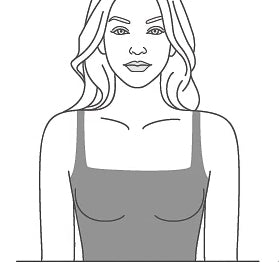
Square neckline
The best necklace to wear with a square neckline is an exact princess-fit necklace with an angular pendant, like a square or a rectangle bar.
However, the instructions differ between shallow and deep square necklines. Here is what you need to know:
- A shallow square neckline goes well with dainty necklaces with small to moderate-sized pendants.
- A deep square neckline often combines well with lengthier necklaces that fall on or even below the bust.
- Layered designs and irregular shapes like triangles and hexagons tend to complement a square neckline.

Sweetheart neckline
A sweetheart neckline is the most feminine neckline out of all. You'll want to emphasize and lean into that appeal with a feminine necklace like a collar with diamonds or crystals.
A princess or a short matinee necklace with a striking centerpiece is also flattering for women wearing a sweetheart neckline.
Your best friend with sweetheart necklines is a feminine material or design like a pearl necklace or a silver chain with a natural stone pendant.

High neckline
The best necklaces for high necklines are princess and matinee length necklaces. Choosing a necklace that sits directly between your collarbones and bust is the safest way to combine any high neckline with a necklace.
Let's see the dos and don'ts of wearing a necklace with a high neckline:
- A dainty chain with a simple, not too flashy pendant is the most recommended.
- Depending on your style preferences, a longer opera-length necklace also tends to combine well with a high neckline.
- Keep it simple; high necklines can look awkward with too much layering.
- Round and timeless shapes work very well, while asymmetric and unfamiliar shapes are hard to combine with high necklines.

Round neckline
The best necklace choice for round and jewel necklines is an opera or matinee length necklace with a visual appearance or a layered design.
If the bottom of the round neckline sits on or just below your collarbones, a long pendant necklace hanging on or just above your bust is the safest play.
What you should know about combining a necklace with a round neckline:
- Necklaces that sit below the collarbone go best with round necklines.
- Collars, chokers, and other short or skin-tight pieces are a no-go.
- Focusing on layered looks or solitaire necklaces with larger pendants is an excellent way to compensate for the otherwise pretty basic appearance of a round neckline.

Cowl neckline
Combining a necklace with a cowl neckline comes with its challenges, and the signature draped fabric edge on the bust of a cowl shirt or dress doesn't make the task any easier.
Wearing long, extensive, or too harsh necklaces usually takes away from the elegant design of the cowl neckline. And in the worst case, it can even make the jewelry tangle with the draping neckline.
The best necklaces to wear with a cowl neckline are shorter and elegant pieces that leave room for the unique aesthetic of the draped neckline. Dainty princess-length necklaces with a sleek pendant are the preferable choice. However, if you want to wear larger or more engaging jewelry, definitely go with a choker or collar.

Scoop neckline
A scoop neckline combines perfectly with a princess-fit necklace that sits slightly below your collarbones.
Preferably, the necklace would come with feminine shapes or materials, like pearls, gemstones, or crystals, and utilize an elegant chain that compliments the pendant choice.
- The ideal necklace choice: an elegant princess-length pendant necklace that sits slightly below the collarbones.
- The scoop neckline is one of the most versatile, so it'll generally combine sufficiently with almost any necklace type.
Because a scoop neckline is a versatile, feminine neckline meant to bring out the upper chest area and collarbones, choosing a necklace that plays into rather than against the feminine aesthetic is key.

Asymmetric neckline
Asymmetrical necklines are some of the trickiest to combine with a necklace. This leaves many wondering whether they should even bother combining a necklace with an asymmetrical neckline. In short, yes. But it depends.
The nature of an asymmetrical neckline is already quite elegant without any added jewelry, so leaving the necklace out is undoubtedly a viable option. However, choosing the right necklace can almost always elevate the outfit to the next level.
So, what's the best necklace with an asymmetrical neckline?
- Chokers tend to look best with asymmetrical necklines.
- If it's a shallow asymmetrical neckline, consider either a collar or a dainty choker.
- Princess-length pendant necklaces are also a good look with a deep sitting asymmetrical neckline.

Boat neck / Sabrina neckline
The boat neck combines best with an elegant necklace with a smallish pendant that rests on top of the clothing, slightly below the collarbones.
However, the conservative aesthetic of the boat neck often looks adequate without an added necklace.
One of the famous boat neck enthusiasts is the Duchess of Sussex, Meghan Markle. Although she often decides to wear her boatnecks without a necklace, you might be better off with a necklace.
While opting to wear a necklace is preferred for more casual boatnecks, if your boatneck is a very formal dress, a graceful princess-length necklace or no necklace at all are the best choices.

Off the shoulder / Bardot neckline
Because off-shoulder and Bardot necklines emphasize the collarbone area, your necklace choice should play into it.
Chokers, statement necklaces, and pendant necklaces that rest on or just below the collarbones, in general, are the best option for off-the-shoulder and Bardot necklines.
If it's a lower sitting off-shoulder top or dress, matinee and opera necklaces can also add depth and personality.

Halterneck
While cross-wrap halternecks work best without a necklace, regular halterneck tops usually look best when worn with matinee necklaces that sit directly between the bust and collarbones.
Since there are so many different styles of halternecks, here is the critical advice you can apply to any halterneck you'll ever have:
The higher the halterneck, the longer the necklace, and vice versa – deep halternecks that expose much of the chest area and bust tend to look better with shorter necklaces like chokers and short princess necklaces.
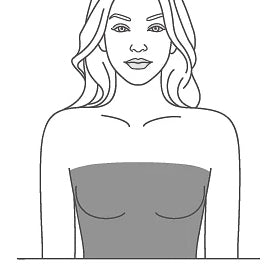
Straight neckline
Princess and matinee necklaces that rest anywhere between the collarbones and bust combine best with a straight neckline.
For a high-rising straight neckline, you might consider an opera chain hanging on your bust area or wrapping around the neck to form a layered appearance.
Deeper straight-neckline tops and dresses can benefit from shorter and simpler necklaces that sit on or slightly below the collarbones.
Furthermore, solitaire and single pendant necklaces that create an angular v-shape above the straight neckline are widely perceived as elegant and feminine.
General instructions for wearing a necklace
How to layer necklaces?
The best way to layer necklaces is to pick 2-4 different length necklaces that only utilize a similar metal color like gold or silver and go from there.
Here's what you need to know to layer necklaces like a professional:
- Amount: although two necklaces are a minimum for a layered look, three is the easiest and most popular necklace amount for a layered look. If you want to dive deep into layering, you can choose four necklaces – any more than five, and you risk looking like a walking jewelry rack.
- Materials: picking one metal color that you use as a basis for all necklaces in your layers is key – combining silver, copper, and gold chains can look awkward. However, pearls, stones, gems, and other materials outside metals can be freely mixed and matched.
- Style: while chains and necklaces without pendants should be positioned closer to the neck area, pendant necklaces should sit lower on the chest area. In fact, the larger the charm, the lower the chain should hang and vice versa.
If you are new to layering necklaces, start with two or three different-length necklaces and see how it feels. Once familiar with the look, you can add one chain or switch up the look.
After all, the key is to have fun with different styles and convey your personality via the different layers of necklaces.
Prevent necklaces from tangling
Whether it's a shirt, your hair, or another chain, tangling necklaces is a real problem. Especially people who travel a lot and want to bring a few of their favorite pieces with them often find their chains in a frustrating mess that takes time to untangle.
This is what you should do:
To keep your necklaces nice and tangle-free while traveling, find yourself regular straws, you know, the ones you drink with, and glide the chain of your necklace through the straw and close the clasp. If you do this straw trick to your every necklace, a small case or a bag like a makeup bag can carry all your necklaces without tangling. I know it's a little unorthodox, but it's the best strategy we've come across, and it works!
To keep your necklaces from tangling to your clothing and hair when wearing them, focus on pendants with round corners and chains with solid, uniform designs like the classic rope chain. If you need layers in your style, avoid wearing two necklaces close to each other in length. In addition, shorter necklaces like chokers and collars rarely tangle with anything.
Necklace turned my neck green, what now?
A necklace turns your skin green because of a process called oxidation. The only way to prevent it is to wear necklaces and jewelry made from metals that don't oxidize quickly.
Jewelry materials that oxidize quickly (turn your skin green):
- Nickel
- Zinc alloys
- Copper alloys
What metals don't turn your skin green:
- Stainless steel
- Sterling silver
- Gold vermeil
- Gold
- Platinum metals
If your skin has turned green from wearing jewelry, don't worry. It's not an allergic skin reaction but a natural oxidation response that happens with some metals. The green color is harmless and washes or wears off within hours.
You can continue wearing any jewelry piece that turns your skin green since it isn't harmful. Although for appearance and convenience, we recommend wearing jewelry and necklaces that don't dye your skin green.
Should I wear my necklace to bed?
If you want, you can wear your necklace to bed. Especially if it's a simple everyday necklace, the risk of choking or breaking the chain is non-existent.
Wearing your necklace to bed is more convenient than taking it off right before bed, just to put it back on after waking up. However, there are a few factors to consider before choosing to sleep with your necklace.
Large necklaces like statement pieces should be removed before going to bed. Similarly, pendants or chains with sharp edges should be taken off before sleeping because they might damage the sheets.
In the end, it's totally up to you. If you want to save time, wearing your necklace to bed makes sense. On the other hand, if you want to ensure your necklace stays in prime condition and don't mind taking the time to put the chain on and off daily, removing it before going to sleep might suit you better.
Showering with a necklace
Although it's okay to shower with gold, silver, or stainless steel necklaces, in general, it isn't recommended.
Because water accelerates the oxidation process of metals, all metals either rust or tarnish after enough water exposure – even pure 24k gold jewelry tarnishes if exposed to enough water or chemicals.
At best, water, especially hot water, leaves the necklace looking dull and inferior in quality. Although this can be countered by regularly polishing your jewelry, it's not ideal. If you want a necklace you can shower with, a waterproof necklace is your best bet.
Here's what you need to know:
If your jewelry is high-quality, wearing it to a short shower, even daily, won't do much to the jewelry in the short term. You can wear your necklace while taking a shower, as long as you avoid long and hot showers and polish your jewelry from time to time.
Is it okay to wear a necklace every day?
It's definitely okay, if not even recommended, to wear a necklace every day.
However, constantly wearing and never taking off your necklace can cause it to lose its shine and tarnish or even rust after years of continuous wearing.
As long as you plan to occasionally (every 6-12 months) polish and clean your necklace, you can continue wearing it daily without taking it off.
Conclusion
That's it. That's all there is to know in order to build a thorough understanding of necklaces and how to wear them.
If you appreciated the article, feel free to mention or tell about it to your friends. You can also support us by purchasing your new favorite necklace from our necklace collection.
I hope you found the answers to your questions and learned something useful from this definitive guide.
Thank you for reading.






